Cell Membrane Surface Analysis #1: Fat cell
Brian Choi, Bio-application scientist
For more information, please contact app@parksystems.com
Data Reference: Dr. Futwan, King Faisal Specialist Hospital and research center
Scanning ion conductance microscopy (SICM) offers myriad opportunities to discover new facts of cell physiology. SICM imaging of fat cells is a good example that exemplifies the value of SICM for cell research. Here, an SICM image shows numerous nanoscale features in detail on the membrane of differentiated and pre-differentiated fat cells. SICM can identify which membrane structures are involved in cellular functions and elucidate specific molecule reaction pathways of the fat cell membrane.
- Detect the surface morphology difference between differentiated and pre-differentiated fat cells
- Observe small biomolecule features on cell membrane surfaces in high resolution (approx. 50nm)
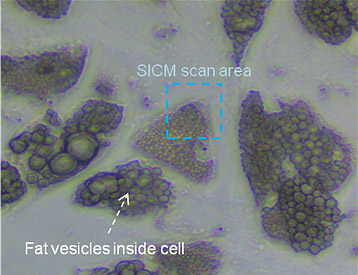 Inverted Optical Microscope
Inverted Optical Microscope
In this experiment, an SICM image was taken at the position where pre-differentiated and differentiated fat cell grow together. In the optical view, the color of a differentiated cell is distinctly darker than a pre-differentiated cell since the differentiated cell contains a large number of fat vesicles inside. In the SICM image, however, such deep color differences are not found because the information SICM offers is of the surface morphology of cells. SICM measurement makes possible discoveries such as small pits, suspect mitochondria features (approx. one micrometer long), and cytosekeletal polymers on the cell membrane. With its high-resolution cell surface imaging capability, SICM offers a totally different approach to microscopic cell biology.
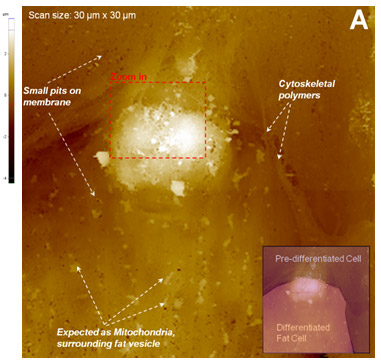 Fat Cell Surface Image, SICM
Fat Cell Surface Image, SICM
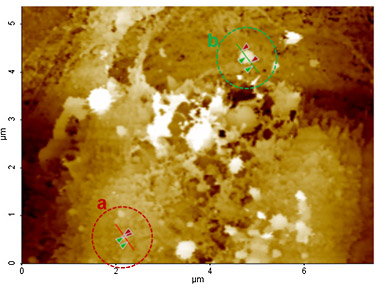
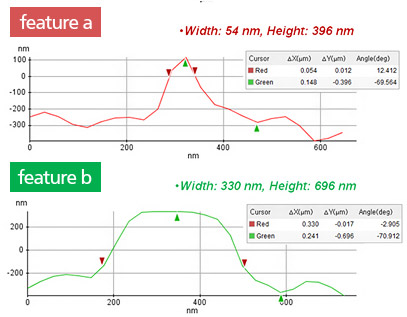 Surface Morphology Analysis
Surface Morphology Analysis
Park Cell Analysis Systems
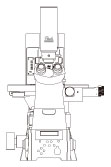
|

|

|
|
| Park NX12-Bio | Park NX10 | Park XE7 | |
| Scanning Ion Conductance Microscopy (SICM) | |||
| Atomic Force Microscopy (AFM) with liquid probe hand | |||
| Inverted Optical Microscopy (IOM) | |||
| Live Cell Chamber |
Cell Morphology Analysis: Fibroblast
Brian Choi, Bio-application scientist
For more information, please contact app@parksystems.com
Cell biologists most frequently use optical cell images, especially for transparent and colourless biological specimens such as cells. In this situation, optical imaging with an inverted optical microscope (IOM) is useful and convenient for determining cell shape and locating edges. However, the optical cell image offers only two-dimensional information on the cell. Although the image seems to offer detailed information about the cell’s inner/outer structures, cells are three-dimensional objects, and this method offers no means of estimating the height information of the cell on the Z axis.
- Distinguishing a cell’s real topography is not possible with inverted optical microscopy (IOM)
- Acquire 3-D cell structure
- Analyze the cell’s volume, size (height/depth), and high-resolution surface image
Technically, the two-dimensional flat cell image is the collection of the applied lights that have passed through the transparent cell. Depending on the refractive cell components in a certain thickness of cell, the angle of the light path changes. The collection of the angle differences is constructed as a two-dimensional cell image. The optical image of the cell displays a mixture of the light signals from all components of the inner/outer cell, making it impossible to distinguish details. Unlike optical microscopic imaging, SICM visualizes cell surface morphology only, generating three-dimensional topography by recording the height information of the cell membrane in a scan area.
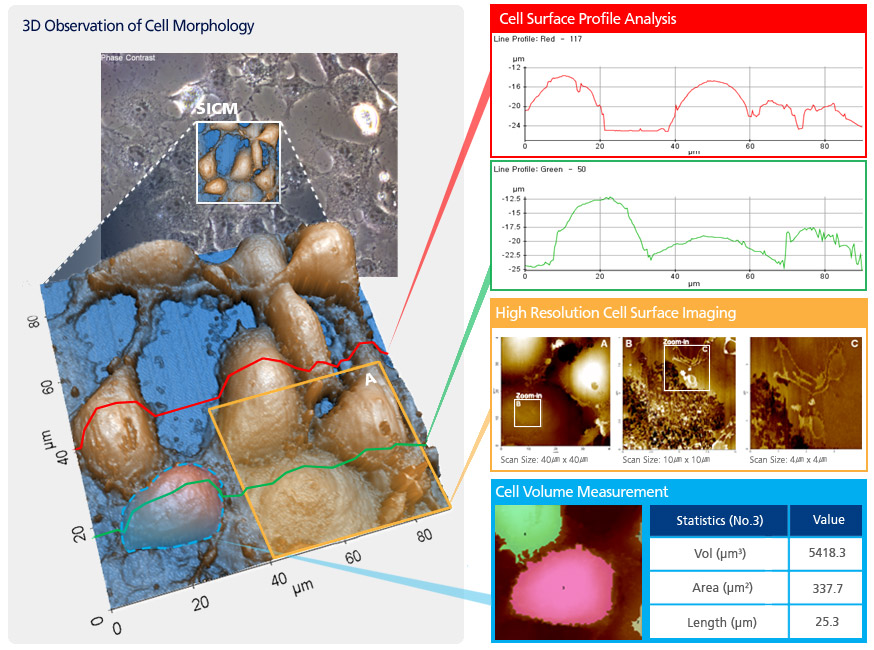
Based on three-dimensional topography data, a researcher can clearly analyze structural and physical properties, such as height, width, depth, length, and volume, in a single cell or multiple cells. Sub-cellular features can also be accurately measured.
Park Cell Analysis Systems

|

|

|
|
| Park NX12-Bio | Park NX10 | Park XE7 | |
| Scanning Ion Conductance Microscopy (SICM) | |||
| Atomic Force Microscopy (AFM) with liquid probe hand | |||
| Inverted Optical Microscopy (IOM) | |||
| Live Cell Chamber |
Exclusive Cell Imaging of Park SICM: Rat Neuron
Brian Choi, Bio-application scientist
For more information, please contact app@parksystems.com
Sample courtesy : Prof. Ushiki, Niigata Univ.
Scanning ion conductance microscopy (SICM) is a new nanoscalemicroscopy specially developed for biological object observation in liquid environments. The nanoscale high-resolution of SICM enables visualizing the details of biologically important features of a size not observable with conventional optical microscopy. SICM’s in-liquid imaging capability allows biologists to observe morphology of biological features as never before possible with scanning electron microscopy (SEM). SICM opens up a new era of microscopic research for biology and life science.
- Discover the physiological phenomena of cells at nanoscale
- Directly acquire a cell’s morphology in-buffer without sample preparation
- Image delicate cell morphology from sub-cellular to tissue level
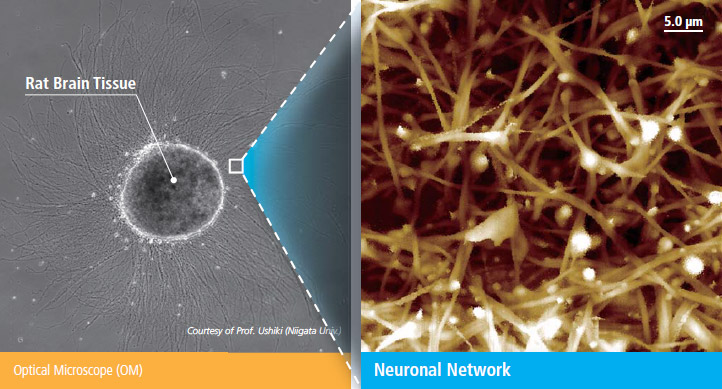
Scanning Ion Conductance Microscope
Neuronal Netwrok, measured in fluid
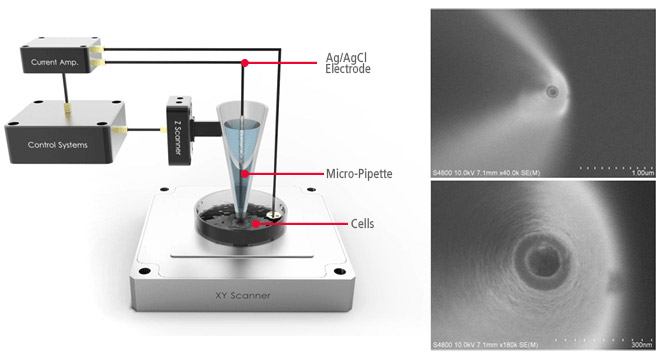
Configuration of SICMNano-pipette End Opening (SEM image)
SICM is a type of scanning probe microscopy and was invented in 1989 in Prof. Hansma’s group. Unlike optical microscopes, SICM uses a glass nanopipette as a sensitive probe with an electrode inside of it. The glass pipette detects nearby surfaces via a decrease in the ion current flow through the pipette.
Park Cell Analysis Systems

|

|

|
|
| Park NX12-Bio | Park NX10 | Park XE7 | |
| Scanning Ion Conductance Microscopy (SICM) | |||
| Atomic Force Microscopy (AFM) with liquid probe hand | |||
| Inverted Optical Microscopy (IOM) | |||
| Live Cell Chamber |
